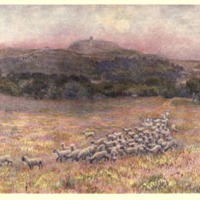Description
In a rather speculative manner, Marcus Huish (writing in 1907) suggest that the young Miles Standish ‘must have frequented’ the local landmark Rivington Pike ‘if only to gain a larger view of the world around him’. The use of speculation, and imagination, exemplifies so much of the creation of the Mayflower narrative, where interest in the story only began centuries after the 1620 voyage. James Rendel Harris’s work on the Mayflower Barn follows in this tradition. The picturesque view is rendered in colourful tones by Elizabeth Chettle, once again connecting the Mayflower to rural tourism. As Huish puts it:
"Another spot that young Miles must have frequented is the ridge of Rivington Pike, undoubtedly then, as now, a much-visited place by Lancastrians. We do not know whether he was alive when the news of the arrival of the Spanish Armada off these shores was announced to the country-side by its beacon taking up the light from Cheshire and passing it on to Cumberland. To see this he must have been over seventy at the date of his death. But as an ardent, adventurous lad he must on occasions have ascended it, if only to gain a larger view of the world around him.
If as he approached manhood his mind became more attuned to Puritan doctrines, it is practically certain that he often-times went thither, for upon its side an old stone delf, having some rude resemblance to seats cut in the rock, has always been handed down by the Puritans of Chorley, Dean, and Bolton, as the sanctuary where their fathers were accustomed to meet every Sabbath morning to hear the 'Godly and comfortable letters which Marsh wrote from his prison, read aloud by some patriarchal Bradshaw, Assheton, Lever, or other elder of his beloved lock.'
The summit of the Pike (1545 feet above sea-level) is crowned with a tower built at the time of the threatened Napoleonic invasion. The journey to the top is well worth making, if a clear day is selected, for the outlook will then extend beyond the vast network of towns, factories, and collieries, to the shores of the Irish Sea and the Bay of Morecambe."

